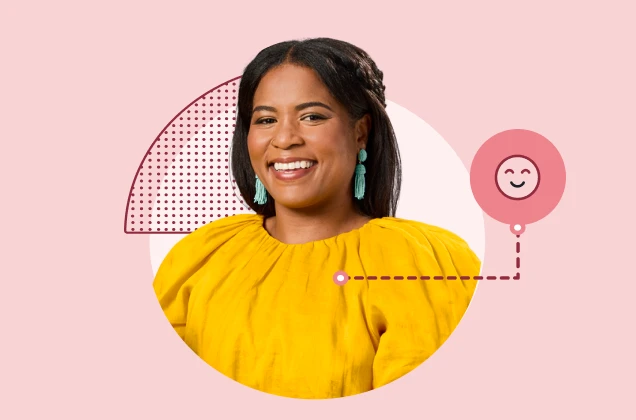How to measure and improve your brand awareness
Improve brand awareness by quickly and easily surveying your target market.
Your business won’t gain new customers and increase your revenue unless people know about it—even if you have the best products or services on the market. Brand awareness is essential to your success, but it’s also something that can be challenging to measure and improve. This guide will help you grow brand awareness for your business so you can bring new customers in the door and build a strong brand for the long term.
What is brand awareness?
Brand awareness is the extent to which people in your target market are aware of your business, products, or services. If your business has high brand awareness, customers are more likely to look for your brand when they go to make a purchase, which gives you a competitive advantage over less familiar alternatives.
Let’s take a closer look at the types of brand awareness and why they matter, as well as the different ways you can measure and increase brand awareness with surveys.
Why is brand awareness important?
Businesses can turn to brand awareness to both measure the effectiveness of their marketing campaigns and benchmark their brand equity. Brand awareness metrics help you understand the consumer behavior of your target market, plan marketing campaigns based on that behavior, manage your brand, and develop long-term marketing strategies.
Say, for example, that your business ran a series of online advertisements to promote a new brand of bottled water. To tell if the marketing campaign was effective, you could measure people’s awareness of your brand as a bottled water company. If brand recognition is high, your campaign was effective. If brand recognition is low, your business might have to take a new marketing approach.
Spot trends and monitor key metrics—easily
Quickly gain meaningful trends from your target consumers before your competitors.
Brand awareness increases trust
Trust is the most valuable currency of the 21st century for businesses. Consumers are faced with so many options when they’re going to make a purchase that they'll look hard to find one they know they can trust. Brand awareness helps you gain trust because once customers have formed a bond with your brand, they’re likely to come back over and over again.
Brand awareness grows brand equity
Brand awareness is the foundation of brand equity, which is the extra value that a business gets from selling a product with a recognizable name, compared to the generic alternative. Once a customer is aware of your brand, they’ll begin to seek you out, and then to prefer you to other brands. Brand equity makes it easier to charge higher prices for products, retain customers, and expand your product line.
Brand equity measures the perceived value of your brand. While sometimes correlated to brand awareness, this is not always the case. For example, a company with a high level of brand awareness can also have a low level of brand equity, like ExxonMobil during the Exxon Valdez oil spill. People were highly aware of their brand as their name was consistently in the news—but for a reason that made many people think less of their brand, thus lowering their brand equity.
Brand awareness creates association
Brand awareness helps create a strong association for actions and products with your brand. When it’s really powerful, it can even encourage us to replace common words with branded terms. This is why we ask for a Xerox of a document when we need copies made, a Band-Aid when we have a cut, or a Kleenex when we sneeze.
The two types of brand awareness
Since brand awareness is so vital, you need to assess how familiar your target market is with your brand. Awareness research helps in measuring brand performance and marketing effectiveness, allowing you to use data to inform your decisions for improvements where necessary.
Brand awareness encompasses two metrics: unaided brand recall and aided brand recognition.
Unaided brand awareness
In unaided brand awareness, participants recall your brand or product name without prompting. This metric measures the number of people who can recall your business, products, or services when they think of your product category. Unaided brand awareness is often a more powerful indicator of purchasing behavior than aided awareness.
To assess your unaided brand awareness, ask questions such as, “What brand comes to mind when you think of laundry detergent?” A follow-up question asking, “Can you think of any other brands of laundry detergent?” may prompt spontaneous awareness.
The first question indicates top-of-mind awareness, and the second is your brand’s total unaided awareness. Asking the right questions with no bias is critical to this assessment. Not sure where to start? Try our brand awareness survey template.
Aided brand awareness
Aided brand awareness measures the number of people who recognize your brand in a list of brand names or logos. This information is important because often, only large brands achieve unaided awareness.
Both aided and unaided awareness metrics are important in gauging how effective your marketing and advertising efforts are. It’s important to note that if your brand is popular enough to come to mind when people think about your product category in general (unaided), then your business has strong brand equity that it can use to boost profit margins.
Brand awareness vs. brand recognition and brand recall
You may have heard the terms “brand awareness,” “brand recognition,” and “brand recall” used interchangeably, but this is incorrect. Each term has a completely different meaning.
Brand recognition
This is another term for aided brand awareness. It is used to evaluate advertising and marketing effectiveness for a brand and to assess whether consumers have at least a minimal awareness of the brand in the market.
Examples:
Which of the following facial tissue brands have you heard of?
- Scotties
- Kleenex
- Puffs
- Up&Up
- Seventh Generation
Brand recall
Brand recall refers to unaided brand awareness. It evaluates the extent to which a brand is associated with a category.
Examples:
- What brand comes to mind when you think about flooring?
- Do you recall seeing any advertisements for flooring in the last two weeks?
- Follow-up question: Can you describe the ads
- Follow-up question: What brand was featured in the ad?
Benefits of measuring brand awareness
Measuring brand awareness reveals information about the relationship between your brand and consumers and how well your brand is performing in its product category.
Measuring brand awareness has four key benefits:
- High brand awareness is good for your bottom line. The more awareness there is of your brand and products, the less you need to spend on advertising. You don’t have to be in a paid space at the top of a Google search page if you are already top of mind with consumers. It’s vital to find out brand awareness metrics and monitor them for changes.
- Inform your brand strategy. As you employ campaigns to improve awareness, track what works and amplify it. This will serve to sculpt your strategy in ways that fit what your target audience responds to.
- Attract new customers. Measuring brand awareness lets you know what strategies are attracting new customers to your brand. Remember to track social mentions and hashtags as part of your brand campaigns. Use this information to inform marketing campaigns to build your brand.
- Monitoring your brand awareness is a key part of understanding your brand health and what impacts sentiment.
How to measure brand awareness
Even though SurveyMonkey has found that 80% of marketers think measuring brand awareness is “extremely” or “very” important, few know how to use it to judge the success of their marketing campaigns. More than 75% of marketers say they don’t know how many people in their target market are aware of their brand, and almost 70% say they don’t even know how to measure brand awareness.
Quantitative metrics
While it can be tricky to put a number to your brand awareness, it’s not impossible. In fact, there are several quantitative metrics that can help you paint an overall picture of your current brand awareness.
- Direct traffic
This is the number of people who visit your website by typing in your URL directly. This number tells you how many people are prompted by your marketing to visit your site—if they’re going there directly, they're definitely aware of your brand. - Site traffic numbers
This number tells you how many people overall are visiting your site, regardless of how they got there. These people are aware enough of your brand to check out your website. - Social engagement
Engagement means the amount of likes, saves, followers, retweets, comments, and more—anything that involves a person taking an action on your social media channels. This tells you how many people are aware of and engaging with your brand.
Qualitative metrics
Qualitative metrics are not as definitive as quantitative ones, and they’re a bit harder to track as well. But they’re still important to include so you get a well-rounded picture of brand awareness.
Google Alerts
Learning how people talk about your brand online offers valuable insights into brand awareness. You’ll receive alerts any time your business is mentioned by a third party or a news outlet.
Social listening
Monitoring your social media management tools for engagement and organic mentions can also offer timely insights into your current brand awareness.
Brand awareness surveys
Luckily, it’s easy to test your target market with a brand awareness survey. A brand awareness survey is a questionnaire that measures how aware your target audience is of the existence of your brand, as well as their perception of it.
Brand awareness surveys gather direct feedback on several elements of your brand:
- Brand recognition: how familiar consumers are with your brand?
- Brand recall: does your brand spontaneously come to mind when thinking about your product or service?
- Brand identity: are your mission and vision recognized and understood?
- Brand image: what do people think of when thinking of your brand?
This survey should include both open-ended and multiple-choice questions so you can gauge unaided and aided brand awareness.
Make an impact with surveys
Quickly gain meaningful trends from your target consumers before your competitors.
Open-ended questions
In open-ended questions, ask respondents to recall brand names, brand attributes, and other product category associations. These questions give you insights into how your target market views your business, products, or services in the most general sense. Ask open-ended questions first, so that the content of your other questions doesn’t influence the results.
Here’s an example of an open-ended brand awareness question:
What bottled water brands are you familiar with? (Please type your answers in the box below)
Multiple-choice questions
In multiple-choice questions, on the other hand, you’ll want to test whether respondents can recognize your brand in a list of your competitors’ names. Here’s how that might look:
Which of the following bottled water brands have you heard of? (Select all that apply)
- Aquafina
- Dasani
- SmartWater
- [Insert your brand name]
- Fiji
Competitive insight questions
You may also want to include questions that dive deeper into your competitors’ brand awareness. These competitive insights give you an edge on your competition and help you come up with marketing strategies that are more responsive to current market conditions.
Ready to find out where your business stands on brand awareness? Get started with our brand awareness survey template.
Brand tracking
Tracking your brand over time can help you measure changes in brand awareness. It will help you set a baseline to begin with so you know where you currently stand, and will measure changes so you can see if your efforts to improve brand awareness are working. Brand tracking can also help you measure how customers feel about your brand, what they expect from your brand and if their expectations are being met, and whether they're planning to purchase your products or services.
The best way to conduct brand tracking is by using a brand tracking tool such as SurveyMonkey. It will help you spot trends in real-time, monitor key brand awareness metrics, and watch the evolution of your brand over time.
How to increase brand awareness
The results of your brand awareness survey will help you come up with effective strategies for increasing your brand awareness. If the conditions are right, any kind of marketing can increase brand awareness. Here are just a few ideas:
Social media
Social media is a particularly effective way to grow your brand awareness, since it makes it easy to build customer networks and spread information about your brand to new people. In fact, more than 50% of your brand’s reputation now comes from online sociability. A social campaign like a contest or a brand hashtag is a great way to help your brand go viral. Plus, you can use your social media platforms to show off your brand’s voice and continuously engage with customers.
Sponsored events
Sponsoring events guarantees that your name will get in front of a large number of people in your target market. For example, Gatorade sponsors large events, like the Ironman World Championship, smaller local events, like half marathons, as well as the Player of the Year high school athlete contest. This not only connects Gatorade with people in its target market, it also helps the brand become associated with the event’s personality, including characteristics like endurance, excellence, and dedication.
Guest content
Like sponsoring events, collaborating on guest content introduces your brand to new audiences. Whether you’re guest posting a blog or inviting an influencer to contribute on your own company blog, it’s an opportunity to build brand awareness and industry relationships simultaneously. Make it a point to diversify your content by creating videos, infographics, and guides that can be easily shared on your social media and your partner’s. Above all, make sure your guest content is unique, helpful, and representative of your brand.
No matter what brand awareness strategy you try, be sure to benchmark all of your marketing campaigns by routinely testing your target market with a brand awareness survey. This can be done on a schedule (for example, biannually) or after specific marketing campaigns to evaluate their impact. By measuring your brand awareness at least two times a year, you can build more effective marketing strategies that are firmly grounded in up-to-date metrics.
Give your brand a personality
Your brand doesn’t need to be a stuffy, old-fashioned image to gain customer trust, at least in most industries. In any case, your brand should have its own personality that represents its values, and helps it connect with customers and stand out from your competitors. When your marketing incorporates a personality that resonates with your target audience, you can’t help but boost brand awareness because your brand will stand out and shine through.
Customers and prospects will form stronger connections and awareness of your brand if it has a compelling personality of its own, including a memorable voice. The personality doesn’t need to be totally out there or offensive to be memorable, but it should talk to your customers like it is a person and not a business.
Create shareable content
Creating content is easier than ever these days, and it is also a fun way to raise awareness of your brand. With all the time most people spend on the internet these days, it’s easy to get in front of potential customers.
For example, you can create free videos that help people solve a problem related to your products, such as home baking tips and tricks from a housewares brand. Content can be written, such as blogs and ebooks, but don’t overlook how much people love sharing videos, infographics, and social media posts.
Your content should be shareable to get the most impact. That’s because you’ll get a free boost in your marketing efforts when other people begin to share what your brand has created, spreading greater brand awareness without increased marketing costs. And since people trust content shared by those they know more than slick marketing campaigns, you’ll also be increasing their trust in your brand.
Run brand awareness campaigns
Running an effective brand awareness campaign requires thinking carefully about your goals for the campaign and how to best achieve them. A general marketing campaign that attempts to increase sales may also boost brand awareness, but it might now. A brand awareness campaign is specifically designed to increase brand awareness as its main goal.
There are several ways to approach brand awareness campaigns. You can set up native ads on publications that are read by your target audience, such as news sites. These ads are easy to set up and scale, and are highly effective at building brand awareness.
You can also run brand awareness campaigns on social media platforms such as Facebook, Instagram, or Twitter. If your brand is not already well-established, you can pay to boost your posts so they’re seen by your target audience. This approach is effective because it’s difficult to get organic content seen these days, so paid posts will have much more visibility and engagement.
Partnering with influencers on social media sites can also significantly and quickly increase brand awareness if their audience overlaps with your target. Influencers are typically seen as trustworthy sources, so you can easily get in front of their audience and increase their memory of your brand and their trust in it as well.
Brand awareness campaigns are all about distributing your content and getting it in front of the right audience—one your business wants to attract. The main goal is not immediately converting them to customers, but instead ensuring they remember your brand and begin to trust it. These efforts will pay off in higher sales and increased brand equity down the road as you continue to build those relationships.
Advertise
Reach a large audience by delivering your advertising to the population at large. By putting your brand out there for all to see, you’ll drive awareness of your brand, products, and services. You'll definitely increase brand awareness with distinctive advertising that differentiates your brand.
Examples of advertising channels:
- Television
- Streaming services
- Radio
- Social media
- Google, Bing, etc.
- Magazines and newspapers
Use public relations
Work with journalists, publications, websites, and influencers to increase awareness of your brand. Favorable coverage through these channels, especially those that have a large following, can be a boon to your brand.
Take action by measuring your brand awareness
The market is crowded and competitive. Does your brand stand out? Measure your brand awareness to find out if your brand, product, or service is breaking through your competitors’ marketing and advertising. Then, use the data to inform decisions to reap the benefits of brand awareness.
Grow your business by measuring, monitoring, and increasing your brand awareness with the SurveyMonkey Brand Tracker.
Discover more resources

Understand your target market to fuel explosive brand growth
Brand marketing managers can use this toolkit to understand your target audience, grow your brand, and prove ROI.

Ecommerce Payment Form Template
Streamline your online transactions with our Ecommerce Payment Form Template. Secure, easy to use, and customizable to fit your business needs.

Get started quickly with SurveyMonkey for HR, marketing, and market research pros
How professionals in HR, market research, and marketing can start using surveys--fast.

B2B Thought Leadership Survey Template
Simplify your thought leadership collection with our B2B Thought Leadership Survey Template. Efficiently gather insights to enhance your content production.